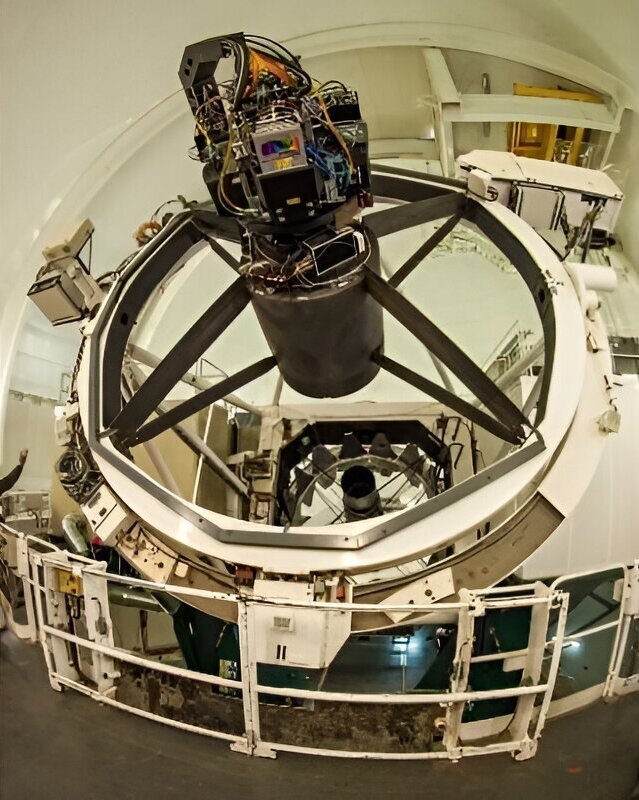
The Physics of the Accelerating Universe Survey (PAUS), an international collaboration across 14 institutions, has covered a sky area of 50 square degrees, similar to approximately 250 full moons.
It was able to determine galaxy distances with unprecedented precision, using the specially designed PAUCam camera on the 4.2-meter William Herschel Telescope (WHT) in La Palma, Spain. This included galaxies more than 10 billion light years away.
Surveys of distant galaxies come in two flavors: photometric surveys, which take high-fidelity images of the sky and capture all astronomical objects that are bright enough to be detected in those images, and spectroscopic surveys, which target a known light source and study its spectrum, i.e. its light distribution over a broad range of wavelengths.
This mode is limited in how many galaxies can be observed, and how faint those can be, but gives a wealth of information about each galaxy.
Collaboration member Professor Benjamin Joachimi, of the UCL Department of Physics & Astronomy, explained that PAUS “combines the advantages of photometric and spectroscopic surveys.”
He said, “We do take images and therefore capture all visible objects in the sky, but do so by putting narrow wavelength filters on the camera such that we know the light we collect originates from a certain part of the spectrum. By using 40 such filters, we can reconstruct a low-resolution version of the galaxy’s spectrum.
“The survey will enable us to explore how galaxies connect to their environment, which mostly consists of dark matter, and to understand how far away galaxies of a certain type and brightness are, which helps us do more accurate science with surveys that don’t have this information.”
The new catalogue will enable astronomers to create more accurate maps to understand how structure forms in the universe and to study the universe’s expansion under the influence of dark matter and dark energy.
Dark energy is thought to constitute about 70% of the universe and be responsible for the universe’s accelerating expansion, yet its nature remains a mystery.
The collaboration was led by the Institute of Space Sciences (ICE-CSIC), supported by Spain’s Ministry of Science, Innovation and Universities. The data was collected over 200 nights between 2015 and 2019. The catalogue is available on the PAUS website and the CosmoHub web portal.
Professor Enrique Gaztañaga, Director of the PAU Survey based at the University of Portsmouth, ICE-CSIC and the Institute of Space Studies of Catalonia (IEEC), said, “The PAU Survey offers a groundbreaking approach to creating cosmic maps, made possible through the design and development of a novel instrument and a dedicated survey to collect and analyze data in ways never done before. It has been a privilege to collaborate with such a talented and dependable group.”
The catalogue release is detailed in two articles. One on calibration of the PAUS data has been published in the Monthly Notices of the Royal Astronomical Society. The other, on measuring distances, has been accepted for publication by MNRAS and is available on the arXiv preprint server.
David Navarro-Gironés, Ph.D. student at ICE-CSIC and first author of the arXiv paper, said, “The great advantage of PAUS is that it …[allows] for highly accurate distance measurements. This level of precision is crucial for the study of the structure of the universe, which in turn requires data from a large number of galaxies.”
Nine years after its first light in 2015, PAUS is able to measure the distances of numerous distant galaxies with a relative precision of 0.3%. The team is currently using this data to enhance the calibration of existing cosmological surveys.
For instance, PAUS data is being used to improve weak lensing analyses and simulations for dark energy missions such as the European Space Agency’s Euclid mission, whose massive optical camera was built by an international team led by UCL researchers, and the Rubin Observatory’s Legacy Survey of Space and Time (LSST).
More information:
F J Castander et al, The PAU survey: photometric calibration of narrow band images, Monthly Notices of the Royal Astronomical Society (2024). DOI: 10.1093/mnras/stae1507
David Navarro-Gironés et al, The PAU Survey: Photometric redshift estimation in deep wide fields, Monthly Notices of the Royal Astronomical Society (2024). DOI: 10.1093/mnras/stae1686. On arXiv: DOI: 10.48550/arxiv.2312.07581
Provided by
University College London
Citation:
Precise locations of more than 1 million galaxies revealed (2024, September 28)
retrieved 28 September 2024
from https://phys.org/news/2024-09-precise-million-galaxies-revealed.html
This document is subject to copyright. Apart from any fair dealing for the purpose of private study or research, no
part may be reproduced without the written permission. The content is provided for information purposes only.
